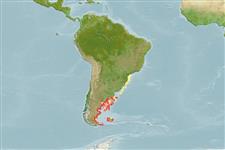Klassifizierung / Names
Namen | Synonyme | Catalog of Fishes(Gattung, Arten) | ITIS | CoL | WoRMS | Cloffa
>
Perciformes/Zoarcoidei (Eelpouts and pricklebacks) >
Zoarcidae (Eelpouts) > Lycodinae
Etymology: Argentinolycus: Named for Argentina, where the species is known mainly from the Argentine Patagonia, and the Greek 'lykos' (= wolf), a commonly used suffix for southern hemisphere zoarcid genera..
Environment: milieu / climate zone / depth range / distribution range
Ökologie
seewasser demersal; tiefenbereich 0 - 40 m (Ref. 11954). Temperate
Southwest Atlantic: Puerto Madryn, Argentina to Tierra del Fuego in the south.
Size / Gewicht / Alter
Maturity: Lm ? range ? - ? cm
Max length : 14.7 cm SL Männchen/unbestimmt; (Ref. 11954)
Kurzbeschreibung
Bestimmungsschlüssel | Morphologie | Morphometrie
This species is distinguished by the following characters: elongated and depressed neurocranium; parasphenoid wing is broad and without dorsal ramus projecting above ventral base of trigeminofacialis foramen; articulating frontal and parasphenoid; enlarged pterosphenoid; intercalar very small and set posteriorly; separate frontal bones, the frontal corner tapering; parietals meet in dorsal mid-line; small supraoccipital, with exoccipital narrowly articulating posteriorly; sphenotic excluded from parietal by frontal and pterotic; posterior ramus of hyomandibula is elongated; well developed palatopterygoid series; ectopterygoid overlap both anterior and dorsal surface of quadrate; ceratohyal-epihyal juncture with bone interdigitating along its entire length; 6 branchiostegal rays; 7-8 suborbital bones, its canal with 6 pores; no posttemporal ventral ramus; scapular foramen enclosed, scapula with well developed posterior strut; postcleithrum present; vertebrae asymmetrical, 22-24+62-69 = 84-90; well developed oral valve; gill slit extending ventrally to slightly below lower end of pectoral-fin base; absence of interorbital or occipital pores and commissure across parietals; suborbital pores along ventral ramus (6+0); nasal pores 2; only postorbital pore 4; lateral line mediolateral complete; no pyloric caeca; pelvic-fin membranes excised at tip; presence of scales, palatine and vomerine teeth (Ref. 90127).
Inhabits the intertidal zone to about 40 m (Ref. 11954).
Life cycle and mating behavior
Maturities | Fortpflanzung | Spawnings | Egg(s) | Fecundities | Larven
Anderson, M.E., 1994. Systematics and osteology of the Zoarcidae (Teleostei: Perciformes). Ichthyol. Bull. J.L.B. Smith Inst. Ichthyol. 60:120 p. (Ref. 11954)
IUCN Rote Liste Status (Ref. 130435)
Bedrohung für Menschen
Harmless
Nutzung durch Menschen
Tools
Zusatzinformationen
Download XML
Internet Quellen
Estimates based on models
Phylogenetic diversity index (Ref.
82804): PD
50 = 1.0000 [Uniqueness, from 0.5 = low to 2.0 = high].
Bayesian length-weight: a=0.00282 (0.00146 - 0.00545), b=3.20 (3.03 - 3.37), in cm total length, based on LWR estimates for this (Sub)family-body shape (Ref.
93245).
Trophic level (Ref.
69278): 3.3 ±0.4 se; based on size and trophs of closest relatives
Widerstandsfähigkeit (Ref.
120179): mittel, Verdopplung der Population dauert 1,4 - 4,4 Jahre. (Preliminary K or Fecundity.).
Fishing Vulnerability (Ref.
59153): Low vulnerability (10 of 100).
